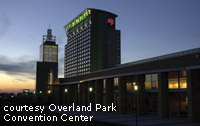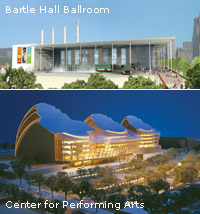The New Millennium
Because of economic woes from the post-September 11, 2001 slump, major developments were limited as Kansas City began the 21st Century. But in several areas, that has turned around.

Kansas City's Downtown is seeing extensive development with plans for the Bartle Hall Ballroom, the Center for Performing Arts and even recent discussion of a new arena, now more substantiated than before. West of Crown Center, the Internal Revenue Service announced in 2003 that its regional service center will move to the former main post office on Pershing Road. The $300 million plan is estimated to represent 4,000 permanent and 2,000 seasonal IRS employees. To the south and adjacent to Penn Valley Park, the Federal Reserve Bank plans a $175 million regional headquarters at 29th and Main. That project will bring another 1,100 workers to the area.

Other downtown deals involve the private sector. The 909 Walnut building sat vacant since the federal government left the 33-story structure in 1995. A Dallas developer is now scheduled to open 180 luxury apartment units with an adjoining seven-story, 350-car parking garage. Total cost of the redevelopment is $55 million.
Back at Crown Center, the 2555 Grand Avenue building was completed in 2003 and is home to KC's largest law firm, Shook Hardy & Bacon.
Hugh Zimmer argues that this project is even more substantial than it might appear. "When you talk about the biggest deals," says Zimmer, "Shook Hardy & Bacon at Crown Center is one of the biggest. It's not that big in terms of aggregate dollars, but in size of the lease--it's huge. It's a $250-300 million lease. A better way to describe it is that it's one of the largest private leases in terms of square feet, 620,000."
Move Over Detroit and Dearborn
Two of the largest recent projects may have been little noticed outside of their immediate industry: modernizing and expansion at the region's two automotive man- ufacturing plants, the Ford Motor Company facility in Claycomo and General Motors plant in Fairfax. Both of these giant complexes have retooled and significantly expanded since 2001, signaling votes of confidence by the two car companies. Ford spent more than $400 million in Claycomo while GM invested $500 million in Fairfax. Between them, these two plants employ nearly 10,000 workers and generate scores of million of dollars in regional support businesses.
Transportation was involved in another recent deal. At the end of 2003, two corporations were selected to redevelop the former Richards-Gebaur Memorial Airport into an industrial park. Hunt Midwest Real Estate Enterprises, Inc. and CenterPoint Properties Trust of Chicago were named to lead the project that is expected to cost more than $500 million and could create 4,000 jobs in an intermodal, industrial and commercial development. In 2004 construction will move swiftly.
Southern Johnson County's continues its often hectic development, including the 2003 opening of the Sheraton Overland Park Hotel and nearby Convention Center. These two projects combined for a total investment of $240 million.
The Next 30 Years?
For the future, Johnson Countian Dennis McKee sees a likely expansion on the K10 corridor, something already indicated by the successful Cedar Creek community, the huge residential development southwest of K7 and K10.
"K10 and I-435 will have a huge influence on this part of the area," McKee predicts. "It's still growing and the entire surrounding area will be affected."
Across town, something similar may happen in Independence, where extension of Little Blue Parkway is projected to create 5,000 new jobs and 20,000 new residents. "It's not farfetched," says the Independence EDC's Tom Reiderer. "You can see that kind of growth now near Independence Center."
Ludwell Gaines III, who founded the magazine that became Ingram's 30 years ago, believes that many of the most successful deals succeeded because business and government leaders were willing to take bold chances. These included a number of developments that came shortly after Kansas City's successes and the Super Bowl.
"Those times made people think that anything was possible," he said. "People believed that Kansas Citians were as good as anyone. People believed it was a time to go forward. Things started to happen."
Ingram's publisher Joe Sweeney, the current steward of the legacy that Gaines started in 1975, does not disagree. "The Kansas City area offers potential much beyond what most people realize," says Sweeney. "The fact the Kansas City area is located literally at the crossroads of North American trade and commerce opens a world of investment opportunities, particularly in the distribution and transportation sectors."
Sweeney sees the absence of mountains and oceans as a benefit, as it relates to economic expansion. There are no natural boundaries to restrict growth and elevate prices. The state line he believes doubles the political clout of the area and will keep all local communities competitive.
"Add the incentives and operational efficiencies of the area to the affordable cost of living and Midwestern work ethic, and Kansas City becomes arguably the most fertile investment market in America," boasts Sweeney.
While the region has witnessed many significant accomplishments over the last three decades, Sweeney is convinced that with business and government bistate collaboration, "The best is yet to come."